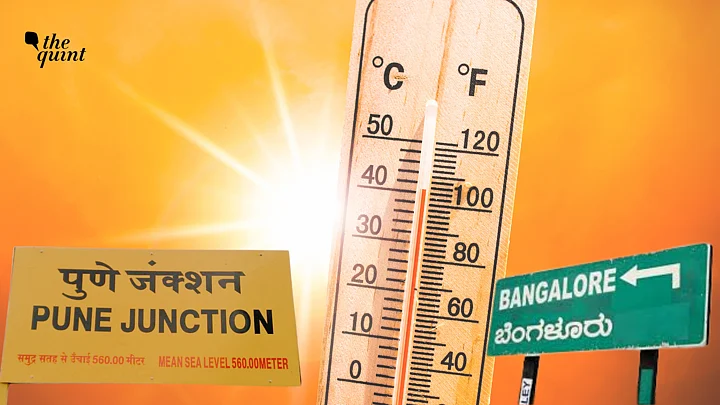This April was the first time in at least 41 years that Bengaluru did not see any rain. In fact, on 25 April, when the city touched 38.5 degrees Celsius, it witnessed its second hottest day in 50 years.
Over the past few years, cities like Bengaluru and Pune – that boasted of 'pleasant' weather throughout the year – have been increasingly becoming hot.
According to the India Meteorological Department’s notice issued on 2 May, Pune will see temperatures between 40-42 degrees Celsius in the coming days.
People from both the cities have recently taken to social media platform X (formerly Twitter) to talk about how they're having to buy/rent air conditioners or coolers due to the rising temperatures, a phenomenon that was unheard of in both the metropolitans till a few years ago.
But how did this change in weather patterns come about? And is it all that sudden? The Quint reached out to experts to understand.
‘The Urban Heat Island Effect’: The Decline of ‘Good Weather’ Cities
Ranjit Gadgil, an environment expert and programme director at Parisar, tells The Quint,
“The overarching reasons are of course climate change and global warming. But while these have contributed significantly, there are many localised reasons as well, including the way we are developing our cities.”
Shripad Dharmadhikary, a Pune-based environment expert who works with Manthan Adhyayan Kendra, agrees.
Dharmadhikary adds, “It has been getting warm in the last few years during the summer, but this is the first time that we are bearing the brunt of heat. It’s also starting to get hot much earlier than usual.”
The reasons, both of them suggest, could be manifold:
Increase in construction and high-rise buildings
Reduction in the cities’ blue and green covers
Increased number of vehicles on the roads, and more roads as well
Impermeable cities where the water doesn’t percolate below surface level (and hence doesn’t help in keeping the cities cool)
Increased energy consumption and production inside the cities
Ever-expanding cities
What both the experts also point to as a significant contributor is the “urban heat island effect.”
According to the United States Environmental Protection Agency, “Heat islands are urbanised areas that experience higher temperatures than outlying areas.”
Dharmadhikary explains, “In urban areas, we are seeing an increase in concretisation, construction, and high-rise buildings. The concrete absorbs the heat during the day and radiates it in the evenings. Earlier, after the sun would set, the cool breeze would blow and there would be no source of heat. But now this trapped heat radiates, making the atmosphere warmer.”
So What Should Be the Way Ahead To Address These Concerns?
Ritu Parchure, who works on the impact of extreme heat with the non-profit organisation Prayas in Pune, tells The Quint,
“With the rising temperatures, India is one of the most vulnerable countries in the world. Extreme heat impacts all sectors including health, agriculture, water, transport, etc.”
For one, she says that there’s an absolute need for mitigation of greenhouse gases to decrease any effects of global warming.
But, on a more local level, the way ahead, according to Parchure, is a multi-sectoral approach to heat adaptation. She says, “We need long term policy making and heat action plans to be brought in place.”
However, she goes on to add, “Whatever our response be, it should be context specific.” What does that even mean?
Parchure says that our vulnerability to heat depends upon a bunch of factors – exposure, sensitivity, adaptive capacity, geographical location, socio-economic parameters, age, access to cooling supplies, among other things.
What we need is to identify who the most vulnerable are, and target heat action policies towards them to safeguard them.
“It’s also important to engage with community stakeholders, educate them, and learn with them,” surmises Parchure.
(At The Quint, we question everything. Play an active role in shaping our journalism by becoming a member today.)
